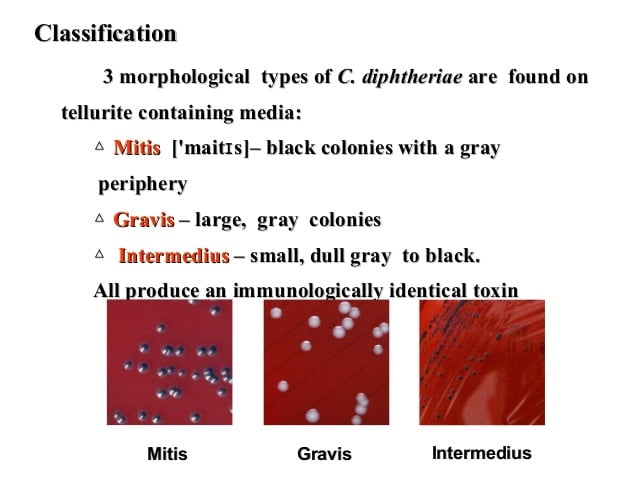Corynebacterium diphtheriae is a nonmotile, noncapsulated, club-shaped, gram-positive bacillus.
Toxigenic strains are lysogenic for one of a family of corynebacteriophages that carry the structural gene for diphtheria toxin, tox.
Corynebacterium diphtheriae is classified into biotypes (mitis, intermedius, and gravis) according to colony morphology, as well as into lysotypes based upon corynebacteriophage sensitivity.

McLeod and Anderson classified diphtheria bacilli, based on the colony characteristics on Tellurite medium and other properties like biochemical reactions and severity of disease.
| Properties | Gravis | Intermedius | Mitis |
|---|---|---|---|
| Morphology | – Short Rods – Uniform Staining – Few or no granules – May be pleomorphic | – Long-barred forms, clubbed end – Poor Granulation – Very pleomorphic | – Long Rods – curved shaped – pleomorphic – Prominent granules |
| Colony on Tellurite Blood Agar | ≥ 2mm, dull greyish black, opaque colonies, daisy head, brittle, like cold margarine. | < 0.5 mm, gray colony, dark center shining surface, frog’s egg colonies | ≥ 2mm, gray, opaque glossy, smooth surface, poached egg colonies, soft buttery, easily emulsifiable |
| Hemolysis | Variable | Non-hemolytic | Usually Hemolytic |
| Glycogen and Starch fermentation | Positive | Negative | Negative |
| Antigen Types | 13 | 4 | 40 |
| Fatality Rate | High | High | Low |
| Complications | Paralytic | Hemorrhagic | Obstructive |
| Endemicity | Epidemic | Epidemic | Endemic |
